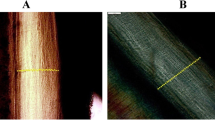Abstract
Over the last 20 years a new chemical method, base on the racemization of aspartic acid, has been developed to be used for the estimation of chronologic age in adult individuals. The method has a good accuracy when used on dental enamel, dentine and cartilage. However, in forensic and archeological cases teeth and cartilage are not always available. Since preliminary studies have shown that there are some age-related changes of the D/L aspartic acid ratio also in bone, this study was carried out to further explore if the method could be used for age estimations of bone. Bone samples from 24 individuals, aged 0.2 to 95.6 years were analysed for the D/L ratios with HPLC-technique. Two different fractions of the bone were examined, an acid-soluble peptide fraction and an acid-insoluble collagen-rich fraction. The analyses showed age-related racemizations in both fractions, although of different rates. The correlation coefficients with age were 0.72 in the peptide fraction, and 0.84 in the collagen-rich fraction. It thus seems as if bone maybe used for age estimations when more stable tissues like dentine and cartilage are not available.
Similar content being viewed by others
References
Helfman PM, Bada JL (1975) Aspartic acid racemization in tooth enamel from living humans. Proc Natl Acad Sci USA 72: 2891–2894
Helfman PM, Bada JL (1976) Aspartic acid racemization in dentine as a measure of ageing. Nature 262:279–281
Ogino T, Ogino H (1988) Application to forensic odontology of aspartic acid racemization in unerupted and supernumerary teeth. J Dent Res 67:1319–1322
Ohtani S, Yamamoto K (1992) Estimation of age from a tooth by means of racemization of an amino acid, especially aspartic acid — comparison of enamel and dentine. J Forensic Sci 37: 1061–1067
Ritz S, Schütz HW, Peper C (1993) Postmortem estimation of age at death based on the aspartic acid racemization in dentin: its applicability for root dentin. Int J Legal Mod 105:289–293
Mörnstad H, Pfeiffer H, Teivens A (1994) Estimation of dental age using HPLC-technique to determine the degree of aspartic acid racemization. J Forensic Sci 39:1425–1431
Man EH, Sandhouse ME, Burg J, Fisher GH (1983) Accumulation of D-aspartic acid with age in the human brain. Science 220:1407–1408
Masters PM, Bada JL, Zigler JS Jr (1977) Aspartic acid racemization in the human lens during ageing and in cataract formation. Science 268:71–73
Ritz S, Schiitz HW (1993) Aspartic acid racemization in intervertebral discs as an aid to postmortem estimation of age at death. J Forensic Sci 38:633–640
Pfeiffer H, Mörnstad H, Teivens A (1995) Estimation of chronologic age using the aspartic acid method. I. On human rib cartilage. Int J Legal Med
Shapiro SD, Endicott SK, Provance MA, Pierce JA, Campell EJ (1991) Marked longevity of human lung parenchymal elastic fibres deduced from prevalence of D-aspartate and nuclear weapons-related radiocarbon. J Clin Invest 87:1828–1834
Ritz S, Turzynski A, Martz W, Schiitz HW (1992) In-vivoRazemisierung von Aspariginsäure in nicht-kollagenen Knochenpeptiden und Lebensaltersbestimmung an der Leiche. Zbl Rechtsmed 38:19
Turzynski A, Ritz S (1994) Demonstration of the marked longevity and low turnover of osteocalcin in bone. Exp Clin Endocrinol 102 [Suppl 1]: 104
Ohtani S, Yamamoto K (1991) Age estimation using the racemization of amino acid in human dentine. J Forensic Sci 36: 792–800
Maroudas A, Palla G, Gilav E (1992) Racemization of aspartic acid in human articular cartilage. Connect Tissue Res 28: 161–169
Author information
Authors and Affiliations
Additional information
This study was supported by grant # B93-241-10277-01 from the Swedish Medical Research Council and from Deutscher Akademischer Austauschdienst grant # 517 023 502 3
Rights and permissions
About this article
Cite this article
Pfeiffer, H., Mörnstad, H. & Teivens, A. Estimation of chronologic age using the aspartic acid racemization method. II. On human cortical bone. Int J Leg Med 108, 24–26 (1995). https://doi.org/10.1007/BF01845612
Received:
Revised:
Issue Date:
DOI: https://doi.org/10.1007/BF01845612




